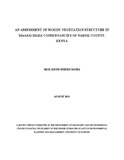| dc.description.abstract | Vegetation structure is a result of adaptation of plants to the environment. Itis important because
it can be used as indications of measuring changes in habitats. Vegetation structure mapping and
monitoring is however not adequately done in most habitats of East Africa mainly because of
cost reasons. Furthermore, protection of habitats especially national parks and reserve prioritize
on animal conservation and not woody plants. It has been observed that the woody vegetation
formations of the Maasai Mara have been deteriorating hence affecting negatively habitat
quality. This has prompted management interventions such as reforestation programmes by the
conservancies. These interventions are however done without much scientific information on the
woody vegetation structure of the study area which can provide focused solutions. This study
examined the woody vegetation vertical, composition, horizontal and temporal structure of six
conservancies (Ol Chorro, Lemek, Mara North, Olare Orok, Motorogi and Naboisho) of the
Maasai Mara ecosystem. Primary data was collected from 108 sample variable transects and 250
sample car transects. In addition, 9 focus group discussions were held with local groups to get
their views on the subject.
The study observed that the conservancies’ landscape could be delineated by use of the woody
vegetation physiognomy into Acacia bushland, bushed grassland, evergreen bushland, evergreen
woodland, grassland, impeded drainage grassland, riverine vegetation, shrubland and
Tarchonanthus bushland vegetation formations using canopy height, cover and indicator species.
An analysis of similarities showed the different vegetation formation as statistically different in
terms of species composition though some overlap exists in the species composition. Mapping
procedures using GIS software Quantum GIS and Google Earth images were used to develop a
vegetation map of the Maasai Mara Conservancies. A total of 7094 woody tree species were
sampled using the variable transects. The results were as follows: Croton dichogamus was the
most dominant species while diversity indices showed riverine vegetation and Tarchonanthus
bushland formations as the most diverse with impeded drainage grassland being least diverse in
respect to woody vegetation. The effect of browsing was evident in 54% of the sampled woody
plants while breakages and human use evidence were 13% and 1% respectively. The
disturbances were height specific; browsing was prevalent in lower height classes of regeneration
while knock over and human use were more prevalent in higher height classes of recruitment and
mature trees. Analysis using Chi-square test showed the occurrence of browsing to be
statistically different at different height classes. The disturbances were also species specific, for
instance, breakages were more pronounced in Acacia species while browsing was prevalent in
Grewia, Maytenus and Phyllanthus species. The population structure of some species such as
Diospyros abyssinica showed decline while others such as Olea africana and Warburgia
ugandensis showed flat structures indicating unhealthy populations.
Although comparisons of the current vegetation map and a map done 40 years ago showed the
general trend of vegetation formation in the study area has not changed, results from focus group
discussions and the absence and/or low frequency of key indicator species show changes in
vegetation composition and some woody vegetation formations especially evergreen woodlands
as generally decreasing in the study area. The study concluded that browsers and breakages
prevent the study area to be woodier and the big tree natured species of the study area as
reducing. It is recommended that more efforts be done to conserve the big trees especially those
of evergreen woodland vegetation formation in areas with lesser extent of browse, human and
breakages disturbances. | en_US |

